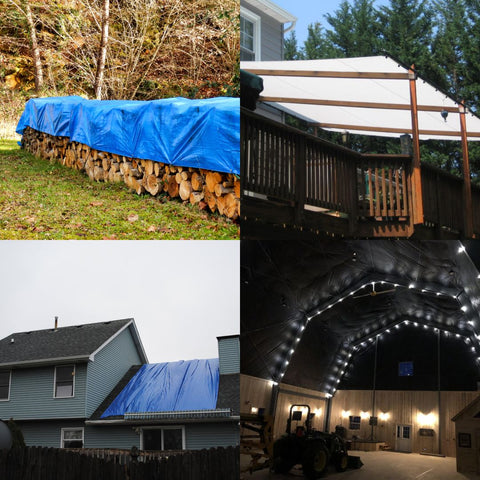When it comes to protecting your valuable belongings from the elements, a poly tarp can be a versatile and cost-effective solution. Whether you need to cover a vehicle, equipment, or outdoor furniture, selecting the right poly tarp is crucial to ensure durability, longevity, and maximum protection. In this comprehensive guide, we will walk you through everything you need to know to make an informed decision when choosing a poly tarp.
1. Understanding Poly Tarps
Poly tarps, short for polyethylene tarps, are made from a synthetic material called polyethylene [1]. They are designed to be waterproof, UV-resistant, and durable. Poly tarps come in various thicknesses, weights, and sizes, and they can be used for both residential and commercial purposes. Before diving into the selection process, it's important to understand the key features and factors that differentiate poly tarps.
2. Purpose and Intended Use

The first step in choosing the right poly tarp is to determine its purpose and intended use. Are you planning to use it for covering a vehicle, protecting outdoor furniture, or securing construction materials? Each application may require different specifications such as size, weight, and durability. Assessing your needs will help narrow down the options and ensure the poly tarp you choose is suitable for the task at hand.
Additionally, consider the tarp's construction. Look for reinforced edges with double-stitched hems and rust-resistant grommets for secure tie-down points. Reinforced corners are also important for added strength and durability.
3. Size and Dimensions
Selecting the right size of the poly tarp is crucial to ensure proper coverage. Measure the area you need to cover and choose a tarp that offers adequate dimensions. Keep in mind that it's better to go slightly larger than smaller to allow for ample coverage and secure fastening.
4. Thickness and Weight
The thickness of a poly tarp is measured in mils. A mil represents a measurement of 1/1000th of an inch [2]. In short, the greater the mil, the thicker tarp. Thicker tarps are generally more durable and can withstand heavy rain, wind, and snow. For lightweight applications, such as covering furniture, a thinner tarp may suffice. Consider the climate and conditions in which the tarp will be used and choose an appropriate thickness and weight.
5. UV Resistance
Exposure to sunlight can cause gradual degradation of poly tarps. UV-resistant tarps are treated with special coatings or additives that protect against sun damage, including color fading and material weakening. When selecting a poly tarp, ensure it offers UV resistance to extend its lifespan and maintain its integrity.
6. Waterproofing and Moisture Resistance
One of the primary features of a poly tarp is to provide waterproofing and protection against moisture. A high-quality poly tarp should have a waterproof coating or laminate that prevents water from penetrating through the material.
7. Color Options
Poly tarps come in various colors, including blue, green, silver, black, white, brown, and camouflage. While color may seem like a purely aesthetic consideration, it can have functional benefits as well. For instance, white tarps reflect sunlight and heat, making them suitable for hot climates. Darker colors, such as black or green, absorb heat and are ideal for colder regions.
8. Durability and Longevity

Investing in a durable and long-lasting poly tarp is essential to ensure that it can withstand harsh weather conditions and regular use. Consider factors such as tear resistance, abrasion resistance, and overall build quality. Check the mil thickness of the tarp, a higher mil means a thicker tarp, and the thickness of a tarp can help determine its expected longevity. Reinforced corners, heavy-duty materials, and double-stitched hems are indicators of a high-quality and durable poly tarp. Additionally, consider the tarp's construction. Look for reinforced edges with double-stitched hems and rust-resistant grommets for secure tie-down points. Reinforced corners are also important for added strength and durability.
9. Price and Value
While price shouldn't be the sole determining factor, it's important to consider the value a poly tarp offers for its price. Compare prices among different brands and models, taking into account the features and durability. Opting for a slightly higher-priced tarp that offers superior quality and longevity can save you money in the long run by reducing the need for frequent replacements.
Conclusion
Selecting the right poly tarp is crucial to ensure optimal protection and longevity. By understanding the purpose, material, size, thickness, UV resistance, waterproofing, and durability, you can make an informed decision. Consider your specific needs, climate conditions, and budget when choosing a poly tarp. Remember, investing in a high-quality poly tarp will provide peace of mind and protect your belongings for years to come. So, take your time, compare options, and select the perfect poly tarp that meets your requirements at www.tarpsupply.com.
Resources:
- https://en.wikipedia.org/wiki/Polyethylene
- https://creativeshelters.com/documents/how-to-choose-a-poly-tarp.pdf





